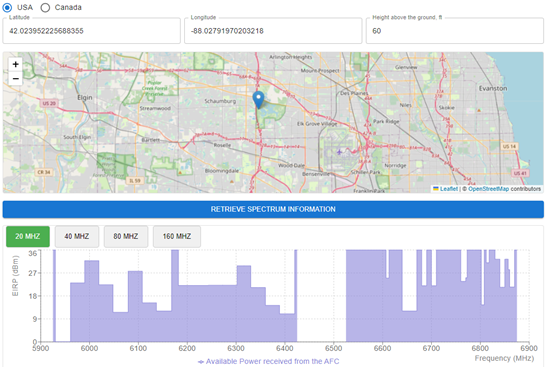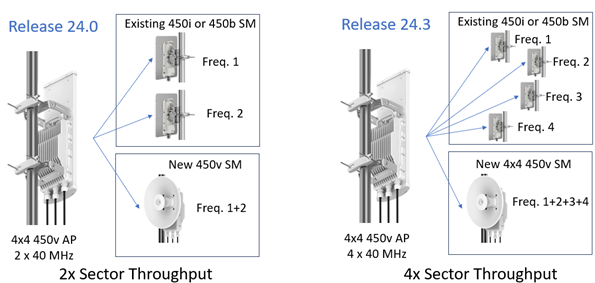The PMP 450v platform is now available as a second fixed wireless PMP solution for 6 GHz from Cambium Networks, joining the ePMP™ 4600. Previously, ISED approval (for 6 GHz use in Canada) was attained, and more recently, the 450v has received the FCC grant for 6 GHz for use in the US. When developing the 450v, our goal was to optimize the PMP 450 platform for the latest needs and requirements of the most demanding Service Providers. The 450v radios bring new features, capabilities, and enhanced performance, while remaining interoperable with existing PMP 450 platform equipment. The 450v also maintains all of the software features that made the 450 platform the flagship point-to-multipoint solution to date.
The 450v is able to provide more bandwidth to more customers, enabling service providers to offer higher bandwidth subscription packages. By providing performance consistent with the advertised speeds and the quality of experience that the subscriber expects, the operator can create customer delight and reduce churn within the network using this equipment.
Interoperability with prior generations of PMP 450 radios can provide more affordable options for deployment as well as seamless migration paths for existing equipment, while new features can help grow the network in both coverage and performance, all while leveraging past investments.
Wide Operating Spectrum
The 450v platform supports operating frequencies from 5.15 GHz up to 7.125 GHz. This is a much wider operating spectrum than the previous radios within this platform and represents new capabilities for this system to cover the newly available spectrum in many regions of the world. While 6 GHz is only commercially available in a few countries today, we expect this band to become more widely available in the near future. In many areas, the use of a shared-spectrum system may be required to convince regulatory authorities to allow more significant use of the 6 GHz spectrum. The 450v platform already supports these methods of dynamic spectrum allocation and can be adapted if new or different sharing methods are chosen for future releases.
The 450v platform will operate in bandwidths from 5 MHz to 40 MHz, similar to prior generations, and to maintain backward compatibility with those systems. However, the 450v will also support additional channel sizes by combining component carriers.
System Operation and Carrier Definition
First, to define the way the system operates, we define the data carrier as the window of spectrum in which a component carrier can be placed. For PMP 450v, this carrier is 100 MHz of spectrum. The component carrier is defined as the energized spectrum (over which data transfer takes place) within the carrier window. In the case of the 4×4 PMP 450v, there will be up to four component carriers, each up to 40 MHz wide. Therefore, the deployment of these component carriers is quite flexible depending on which spectrum might be available to the operator in a given coverage area.
The below figure helps explains this concept:

CC = Component Carrier, BW = (Channel) Bandwidth
The 450v is currently available in both a 4×4 access point (AP) and a 4×4 subscriber module (SM). These radios have multiple carriers (two 2×2 carriers, specifically) in which to place the four component carriers. When these subscribers are operating with prior-generation equipment, such as the PMP 450i or PMP 450b subscribers, they will register with only a single component carrier to transfer data. This system allows for maximum deployment flexibility.
For example, the flexibility of this type of system will allow an operator to separate more narrow channels then aggregate them to maximize the total bandwidth, yet allow this link to operate at the highest possible power. The Automated Frequency Coordination (AFC) system in the United States calculates the type of interference that the PMP 450v might generate and will determine which channels the radio can operate on without interfering with incumbent 6 GHz license holders (i.e., those that operate 6 GHz microwave PTP links). It also determines the maximum allowed power level.
Spectrum Inquiry Tool
Cambium offers a Spectrum Inquiry tool that runs the calculations for maximum allowed power given the coordinates and height of the radio the operator would like to deploy. In the example below, you can see that there are quite a few licensed incumbents that are limiting the power of the radio. If we use a radio that supports only wide channels, there are many areas within the band where the total power would require reduction. However, if the PMP 450v is deployed here, we can operate at 36 dBm (the maximum power) in some smaller channel sizes (and aggregate them) to maximize the throughput yet maintain maximum power (to optimize the range).

In addition, the system could be deployed in multi-sector mode, meaning that two to four component carriers can be configured and SMs within this sector can be assigned to any of these component carriers, effectively resulting in multiple sectors within the same physical location. Simultaneously, the 4×4 450v SM could be added anywhere within this sector to aggregate these component carriers into a single remote location, providing exceptionally high throughput where required, over 1.2 Gbps at the highest modulation. The figures below show these deployment strategies:

In conclusion, Cambium Networks’ PMP 450v represents a significant advancement in fixed wireless broadband technology, particularly for the 6 GHz spectrum. If you are interested in learning more about the PMP 450v platform, view the webinar replay.
